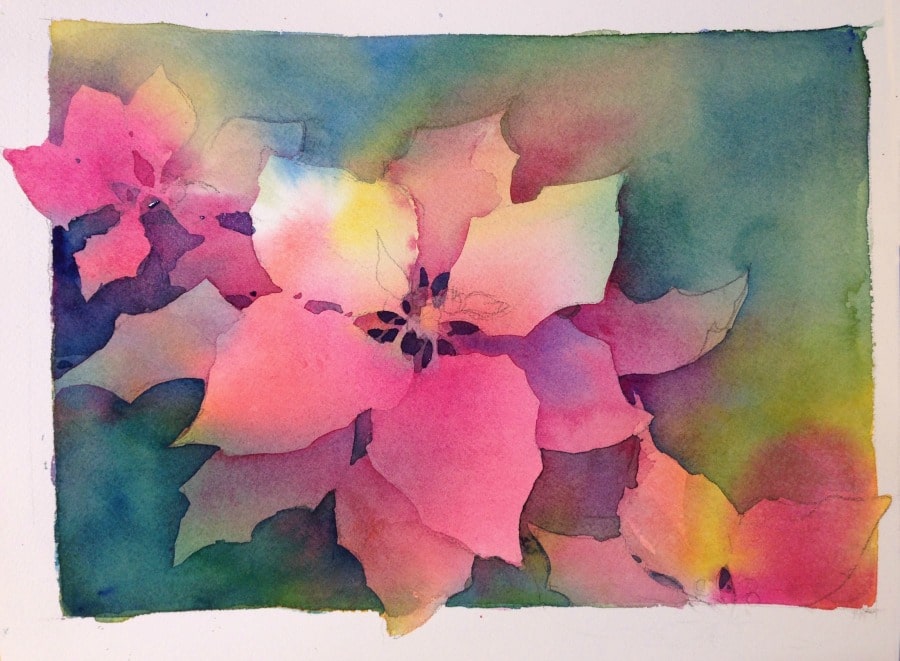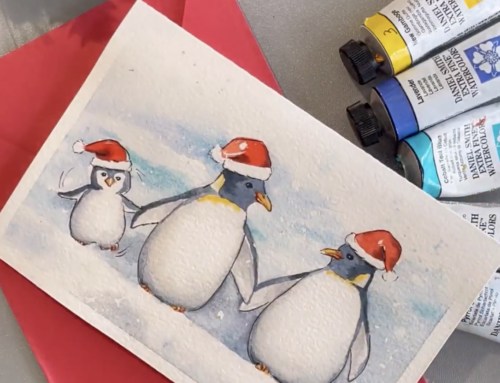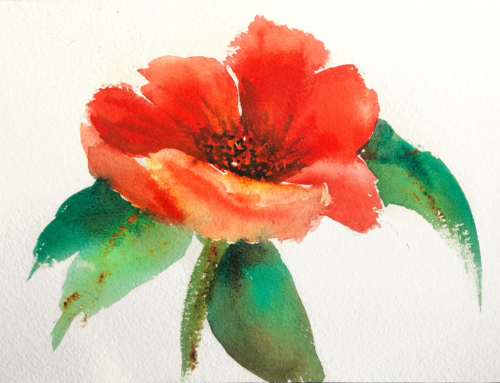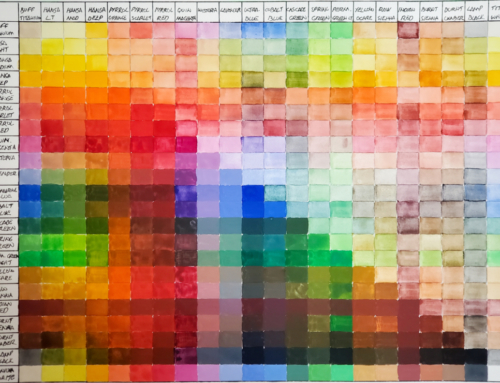Share:
DANIEL SMITH’s Essentials Watercolor Set consists of six tubes of 5ml paints. Each color was carefully selected to give you a wide range of colors. A warm and cool: red, blue and yellow. An amazing range of colors in just six tubes of paints. When mixed together the colors you can mix are endless!

The DANIEL SMITH Essentials Set
Hansa Yellow Light (HYL)
New Gamboge (NG)
Quinacridone Rose (QR)
Pyrrol Scarlet (PS)
Phthalo Blue GS (PB GS)
French Ultramarine (FU)

Poinsettia reference photo from Brenda Swenson
Reference Photo: Cameras are a wonderful tool but it’s important to remember photographs are simply a springboard. I don’t rely too heavily on them. The sooner I respond to what’s happening on the paper and quit looking at the photo the better off I’ll be…especially with the technique of negative painting.

Poinsettia line drawing.
Drawing: I start by drawing the poinsettias with a 2B pencil on Arches 140lb cold press paper. I’m especially aware of the space and shapes between the flowers and leaves (negative space). I want shape and size variety. I draw enough to get the general shapes, but not too much. I intentionally leave areas understated so I’ll have opportunities for negative shapes to develop in the painting process.

Mother colors for poinsettia watercolor
Mother colors: I use transparent paint to build up glazes. I limit my underpainting to 3 colors. To determine which 3 colors I will use I make numerous color swatches. The paints need to be the same consistency (whole milk) to encourage ample mixing on the paper. I’m looking for interesting combinations (how they mix when wet, range of colors, range of values and do they relate to my subject). The 3 paint colors I selected I call my Mother Colors: New Gamboge (NG), Quinacridone Rose (QR), and Phthalo Blue GS (PB GS).

Poinsettia under painting.
Underpainting: I wet the watercolor paper with clean water and introduce the 3 paint colors separately into the wet surface. I paint at an angle to encourage mixing as the paint moves. I don’t overwork the surface with a paint brush but encourage the paint to mix and mingle on the paper. I leave a third of the paper untouched with paint. As it dries the paint will continue to move and hopefully a small amount of light/whites will remain. Let thoroughly dry naturally (without a hair dryer).

Glazing with watercolors for poinsettia painting.
Start Glazing: I continue with my Mother Colors (original 3 colors) and I pull French Ultramarine into the mixing area of my palette. When I bring a new color into the mix it touches one of the original Mother Colors. Why? Having a new color touch one of the original 3 colors creates harmony in the glazing process. When I begin glazing I’ll paint over some of the poinsettia petals, leaves and background at the same time. I start in the upper left hand corner and work clockwise. I paint hard edges against the petals I want to save and soften as I pull away. As I work clockwise around the main poinsettia I vary my colors slightly with the Mother Colors and French Ultramarine. Let thoroughly dry.

Continuing glazing with watercolors for poinsettia painting.
Glazing Continued: Periodically I wipe off my palette especially if the mixing area has become a neutralized mixture. Mud, neutrals or grays are wonderful and every painter should know how to mix them. But know when you want them and how these grays work to make other colors more lively.

Mixing greens from the DANIEL SMITH Essentials Watercolor Set for poinsettia watercolor
Greens: I pull out fresh paint into the center of my palette. I have the Mother Colors (NG, QR, PB), French Ultramarine and the new addition of Hansa Yellow Light. Starting on the left side directly below the poinsettia and working counterclockwise. I use a mixture of French Ultramarine & Quinacridone Rose. I carve out shapes with hard edges against the petals. As I move across the lower section I want my colors to move from purples into the greens. With each brush load I slightly shift the green. Below the center poinsettia is a cooler green and pushes towards the blues. As I move across the lower section (left to right) I carve out more petal shapes. Above the far right poinsettia the greens are much warmer and have more Hansa Yellow Light. The small negative shapes in the center of each flower is a dark mixture of French Ultramarine & Quinacridone Rose. Let thoroughly dry.

Poinsettias Watercolor by Brenda Swenson
Finished Poinsettia Watercolor: As the poinsettia turns from the light I have a variety of shadows. Form shadows have soft edges and cast shadows have hard edges. The shadows on the petals are a darker value of Quinacridone Rose with a touch of French Ultramarine as it turns from the light. When I need to soften the edge of a form shadow I use clean water on the edge before the paint has a chance to dry. The leaves beneath the center poinsettia is the darkest passage of negative painting. I use a mixture of Phthalo Blue GS & New Gamboge, before the paint has a chance to loose its shine I drop a little Quinacridone Rose into the passage. The unexpected warmth brings life to the dark greens.
A few touches of color in the center of the poinsettia and it’s finished.
Conclusion: Hope you’ve enjoyed this short demonstration. If you were unfamiliar with the Essential Set before hopefully I’ve opened your eyes to their wonderful transparency, richness and mixing ability!
Happy Painting!
Brenda Swenson







